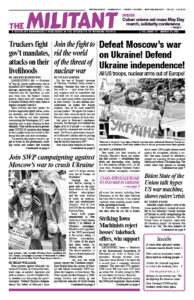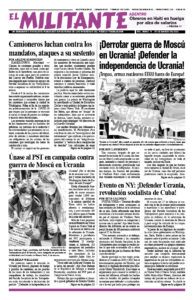On the eve of Russia’s invasion of Ukraine, Vladimir Putin issued a warning, “Anyone who tries to interfere with us … must know that Russia’s response will be immediate and will lead you to such consequences as you have never before experienced in your history.” In case anyone misunderstood, he added that Russia remains, “one of the most powerful nuclear powers.” He upped the threat a few days later, announcing he had put Russian nuclear weapons on high alert.
Just prior to Moscow’s murderous invasion, the Pentagon had doubled the flights of its E-6 aircraft — a vital part of its nuclear command-and-control network. The French government responded to Moscow’s nuclear alert by putting to sea a second nuclear-armed submarine for the first time since 1997.
Ever since these weapons of destruction were first used against the people of Hiroshima and Nagasaki by the U.S. rulers in 1945 — immediately killing an estimated 120,000 men, women and children, with tens of thousands of deaths later from radiation poisoning — the risk exists that the capitalist rulers who possess them will wipe humanity off the face of the earth.
Putin’s declaration led some to say Ukraine’s decision to give up its nuclear weapons in 1994 was a mistake. In an opinion piece in the Wall Street Journal, two former U.S. officials argue that “without them, a peaceful nation is at the aggressor’s mercy.” They say that the U.S. and all other governments that hold nuclear weapons must recognize that.
The Socialist Workers Party calls for a different course. The SWP demands Washington’s immediate unilateral nuclear disarmament and has done so since these weapons were first developed. Like Cuba’s communist leadership, the SWP calls on all governments with these weapons to disarm and to reject development of a nuclear weapons program.
Washington and Moscow — both prior to the collapse of the Soviet Union and under capitalist rule since then — have engaged in an escalating nuclear arms race. Agreements reached between them limiting these arsenals always left both with more than enough to destroy human life on the planet several times over. A growing number of countries have acquired nuclear weapons, and enduring national and class conflicts under capitalism make their use by any of these regimes possible.
“The only way to forestall that possibility … is to build a revolutionary working-class movement powerful enough to overthrow the U.S. capitalist rulers and disarm them,” explains a 1990 SWP resolution, “U.S. Imperialism Has Lost the Cold War,” available in New International no. 11.
In a 2005 interview, Fidel Castro, the central leader of Cuba’s socialist revolution, said, “We have never considered the idea of fabricating nuclear weapons, because we don’t need them.”
“What’s the purpose of producing a nuclear weapon when your enemy has thousands of them?” Castro asked. “Who are you going to use it against? Against the American people? No! That would be unfair and absurd!” He added, “We will never apply methods that sacrifice innocent people.”
“You’ll ruin yourself — a nuclear weapon is a good way to commit suicide at a certain point,” he said. “You’re going to do that against the entire world’s public opinion.”
In 1991 Cuba also made the decision to end work on the Juraguá nuclear power plant that was begun in 1983, with Soviet collaboration. The plant had been planned to augment and replace much of the island’s electrical system that relied on oil, a scarce commodity in Cuba. But after the collapse of the Soviet Union, Castro said, “Who were we going to depend on for nuclear fuel? Yeltsin? Putin? We had no alternative. We decided to halt the work.”
“We possess a weapon as powerful as nuclear power and it is the immense justice for which we are struggling,” Castro said.
Leaders of the revolution start with the capacities of millions of working people to fight to change their conditions, and the fact that they made a socialist revolution worth defending, an example for toilers worldwide to emulate. It’s this weapon that has allowed Cuba — a country of 11 million, 90 miles off the coast of the U.S. — to successfully fend off relentless attacks by the U.S. rulers for more than 60 years.

